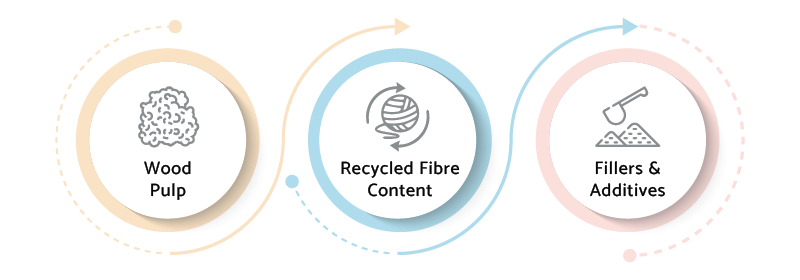Table of Contents
Introduction
Despite its simplicity, paper is an essential part of our daily existence. From critical business paperwork to colourful artwork, the quality of paper products greatly influences its practical use and visual appeal.
This blog will explore the crucial elements that define paper quality, providing you with the knowledge to make well-informed decisions
Ingredients Used for Paper Making
Understanding the building blocks of paper is essential for evaluating its quality.
- Cellulose fibre:
The foundation of paper is cellulose fibres derived primarily from wood. Softwood pulp from coniferous trees offers high strength and long fibres, which are ideal for writing and printing papers. Hardwood pulp from deciduous trees provides a smoother surface and better opacity, making it suitable for higher-quality printing applications. - Sizing Materials:
Starches and rasins are added internally or externally during papermaking. These sizing agents control ink absorption and water resistance. - Fillers:
Clays, calcium carbonate, and titanium dioxide are joint fillers that enhance paper’s smoothness, opacity, and brightness. They reduce show-through, where the ink bleeds through the paper, and contribute to a more visually appealing surface. - Pigments and Dyes:
Coloured paper utilises pigments and dyes to achieve a desired aesthetic. However, print designers should be mindful of potential interactions between coloured paper and coloured inks, as the paper colour can affect the final output.
Key Parameters that Determine the Quality of Paper
Commercial paper product quality is a multi-faceted concept, encompassing various properties that influence its performance and user experience:
A. Raw Material Composition

Wood Pulp
The type of wood pulp plays a significant role. Softwood pulp offers superior strength & tear resistance, making it ideal for copiers & printing paper. Hardwood pulp, with its shorter fibres, provides a smoother surface and higher opacity, which is preferred for high-quality printing applications like brochures & magazines.
Recycled Fibre Content
The inclusion of recycled fibres contributes to environmental sustainability. However, depending on the processing methods and the percentage of recycled content used, it can affect paper strength and opacity. Manufacturers often strike a balance between recycled content and desired paper properties.
Fillers and Additives
The type and amount of fillers and additives used during the initial process significantly impact paper quality. Fillers enhance brightness, opacity, and smoothness, while the brightness of a commercial paper product is measured according to ISO standards, with higher values indicating a whiter appearance.
B. Paper Surface

Smoothness and Finish (Calendering)
Paper smoothness directly affects printability, ink absorption, and writing experience. A smoother surface allows for sharper image reproduction and minimises ink feathering. Calendering, passing paper through rollers under pressure, enhances smoothness. However, excessive calendering can reduce bulk and increase show-through.
Paper Finishes
Paper finishes influence its aesthetics and functionality. A gloss finish offers a shiny, reflective surface, ideal for high-impact visuals in brochures. Matte finishes provide a smooth, non-reflective surface suitable for writing and documents. A Felt finish paper offers a textured and more tactile experience and is often used for stationery or high-end packaging.
Whiteness and Opacity
The whiteness and opacity of paper, measured according to ISO standards, play crucial roles in its visual appeal and functionality. Whiter paper provides a cleaner and brighter appearance, enhancing readability and contrast. Opacity ensures minimal show-through, preventing content from the back of the page from interfering with the front and maximises paper usage
C. Strength Properties

Basis Weight (GSM)
Basis weight, also known as Grammage per Square Metre, refers to the weight of a single sheet of paper per square meter & indicates thickness & strength. Higher GSM signifies thicker and more robust paper, ideal for durable applications like business cards or presentation folders.
Tensile Strength
Tensile strength refers to the paper’s resistance to tearing and stretching. Papers with high tensile strength are less prone to rips and tears during handling or printing processes. This property is crucial for documents that will be frequently handled or folded.
Tear Strength
Similar to tensile strength, tear strength indicates a paper’s resistance to tearing in a specific direction. Higher tear strength ensures higher resistance to tearing and is particularly important for envelopes, packaging materials, & maps that may undergo stress during use.
D. Additional Considerations for Specific Applications

Beyond the core properties discussed above, several factors become relevant depending on the intended use of the paper:
Printability
For printing applications, factors like ink absorbency, surface finish, and dimensional stability (minimal curling or warping) become crucial. Choosing paper with appropriate ink absorbency prevents excessive ink bleeding or dot gain, ensuring sharp and vibrant prints.
Archiving
Papers intended for long-term storage, such as archival documents or historical records, require specific properties. Acid-free paper with high lignin content (removed in lower quality papers) minimises yellowing and brittleness over time.
Internal Bond Strength
This property measures the paper’s ability to resist delamination or ply separation. Strong internal bonds ensure the paper doesn’t shred or flake, maintaining its integrity during printing and handling.
Evaluating Paper Quality
While technical specifications offer valuable insights, directly experiencing the paper can be highly informative. Here’s how to assess paper quality through simple methods:
- Visual Inspection: Hold the paper up to light to check for opacity. Look for a smooth, even surface free of imperfections.
- Touch Test: Run your fingers across the paper to feel for smoothness and texture.
- Writing Test: Try writing with a pen or pencil to assess ink absorption and smoothness.
- Folding Test: Fold the paper several times to observe its folding endurance and check for cracking.
Final Words
By understanding the important factors that affect the quality of paper products, you can make well-informed decisions when choosing paper for any purpose. Whether you’re an artist looking for the perfect canvas, a business professional needing high-quality presentation materials, or someone who values a good writing experience, this guide will help you select the best paper for your needs.


